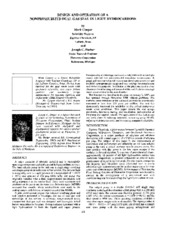| dc.contributor.other | International Pump Users Symposium (16th : 1999) | |
| dc.creator | Cooper, Mark | |
| dc.creator | Parker, Joseph C. | |
| dc.date.accessioned | 2017-10-05T16:49:01Z | |
| dc.date.available | 2017-10-05T16:49:01Z | |
| dc.date.issued | 1999 | |
| dc.identifier.uri | https://hdl.handle.net/1969.1/164103 | |
| dc.description | Lecture | en |
| dc.description | pg. 101 | en |
| dc.description.abstract | A major producer of ethylene installed and is successfully operating a nonpressurized dual gas seal in liquid methane service. The least reliable pump in the unit was a single stage overhung centrifugal pump in demethanizer reflux service. The process fluid is marginally over its vapor pressure at a temperature of -140 F (-96 C) and pressure of 502 psig (3461 kPa). The pump was originally installed with a dual nonpressurized mechanical seal using n-propanol as the barrier fluid. There were numerous seal problems on the pump and the mean time between repair (MTBR) averaged four months. Many modifications were made to the sealing system with little or no improvement in the MTBR. A joint development project was initiated involving plant and seal supplier personnel to investigate the use of dual gas seal technology in this service. A cartridge, nonpressureized series arrangement dual gas seal was designed and thoroughly tested before installation in the plant. Testing included operation with a light hydrocarbon in both the liquid and vapor phases. Incorporating an interstage and external labyrinth with an inert gas sweep satisfied low environmental emissions requirements. A purge and vent control panel system was developed to monitor and establish appropriate gas purge and vent settings for containment and emissions purposes. Installation at the plant included a close clearance throat bushing and removal of the seal flush to encourage vapor accumulation in the seal chamber. The first seal was installed in the plant on January 1, 1997, and has operated through November 1998 without problems. The methane vapor emissions at the outboard labyrinth are consistently measured at less than 250 parts per million. The seal has dramatically improved the reliability of this critical pump even under upset conditions. This paper details the seal design parameters, laboratory testing, seal installation, and operation of the pump and support system. The application of this technology can assist plants in reducing emissions, increasing pump MTBR, reducing maintenance costs, and increasing equipment reliability. | en |
| dc.format.medium | Electronic | en |
| dc.format.mimetype | application/pdf | |
| dc.language.iso | en | |
| dc.publisher | Texas A&M University. Turbomachinery Laboratories | |
| dc.relation.ispartof | Proceedings of the 16th International Pump Users Symposium | en |
| dc.subject.lcsh | Pumping machinery | en |
| dc.title | Design And Operation Of A Nonpressurized Dual Gas Seal In Light Hydrocarbons | en |
| dc.type.genre | Presentation | en |
| dc.type.material | Text | en |
| dc.identifier.doi | https://doi.org/10.21423/R1K678 | |


